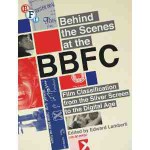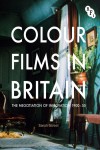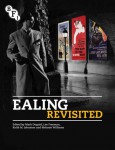 Behind the Scenes at the BBFC: Film Classification from the Silver Screen to the Digital Age
Edited by Edward Lamberti (foreword by Mark Kermode)
(BFI/Palgrave Macmillan, 23 Nov 2012), 256 pages
ISBN: 978-1844574766 (Paperback), £19.99
Behind the Scenes at the BBFC: Film Classification from the Silver Screen to the Digital Age
Edited by Edward Lamberti (foreword by Mark Kermode)
(BFI/Palgrave Macmillan, 23 Nov 2012), 256 pages
ISBN: 978-1844574766 (Paperback), £19.99
Established by the film industry in 1912 as the nation's only official and independent classifier of the moving image, the British Board of Film Classification (originally the British Board of Film Censors) has long been a source of fascination – and sometimes a bone of contention – for filmgoers, filmmakers and industry figures. This new book, published in the BBFC's centenary year, addresses Britain's film classification history, and marks an unparalleled collaboration between the Board and leading film critics, historians and cultural commentators. These writers, given unprecedented access to the BBFC's archives, chart the organisation's history alongside the cultural, social and political forces that have helped shape it. Together they explore shifting public attitudes towards cinema's portrayal of sex and drugs, horror and violence; the different perspectives of the Board's successive leaders; the impact of controversial decisions, and the ever-changing nature of moving image distribution and exhibition. The book also features unique case studies, written by BBFC staff, focusing on significant films that have provoked debate and controversy both within the BBFC and more widely - Battleship Potemkin, The Snake Pit, A Clockwork Orange, Indiana Jones and the Temple of Doom, and many more. Contributors include: Catherine Anderson, Sian Barber, Simon Brown, John Carr OBE, Stephen J. Chibnall, Robin Duval CBE, Tracy Hargreaves, Geoffrey Hawthorn, Robert James, Gerard Lemos, Aidan McDowell, Caitlin O'Brien, Guy Osborn, Murray Perkins, Julian Petley, Ann Phoenix, Stevie Simkin, Alex Sinclair, Sir Quentin Thomas.
About the Editor: Edward Lamberti is Information Services Manager at the BBFC and a PhD candidate in the Film Studies department at King's College London.
 Colour Films in Britain: The Negotiation of Innovation, 1900-50
By Sarah Street, with a Technical Appendix by Simon Brown
(BFI/Palgrave Macmillan, 26 October 2012), 320 pages
ISBN: 978-1844573134 (hardback), £60
ISBN: 978-1844573127 (paperback), £18.99
Colour Films in Britain: The Negotiation of Innovation, 1900-50
By Sarah Street, with a Technical Appendix by Simon Brown
(BFI/Palgrave Macmillan, 26 October 2012), 320 pages
ISBN: 978-1844573134 (hardback), £60
ISBN: 978-1844573127 (paperback), £18.99
How did the coming of colour change the British film industry? Unlike sound, the arrival of colour did not revolutionise the industry overnight. For British film-makers and enthusiasts, colour was a controversial topic. While it was greeted by some as an exciting development – with scope for developing a uniquely British aesthetic – others were deeply concerned. How would audiences accustomed to seeing black-and-white films – which were commonly regarded as being superior to their garish colour counterparts – react? Yet despite this initial trepidation, colour captivated many British inventors and film-makers. Using different colour processes, these innovators produced films that demonstrated remarkable experimentation and quality. Sarah Street's illuminating study is the first to trace the history of colour in British cinema, and analyses the use of colour in a range of films, both fiction and non-fiction, including The Open Road, The Glorious Adventure, This is Colour, Blithe Spirit, This Happy Breed, Black Narcissus, The Red Shoes, The Tales of Hoffmann and Moulin Rouge. Beautifully illustrated with full colour film stills, this important study provides fascinating insights into the complex process whereby the challenges and opportunities of new technologies are negotiated within creative practice. The book also includes a Technical Appendix by Simon Brown (Kingston University, UK), which provides further details of the range of colour processes used by British film-makers.
About the Authors:
Sarah Street Professor of Film at the University of Bristol. Her publications include Cinema and State: The Film Industry and the British Government, 1927–84 (co-authored with Margaret Dickinson, 1985); British National Cinema (1997, 2nd edition 2009); British Cinema in Documents (2000); Transatlantic Crossings: British Feature Films in the USA (2002); Black Narcissus (2005), and Film Architecture and the Transnational Imagination: Set Design in 1930s European Cinema (coauthored with Tim Bergfelder and Sue Harris, 2007). She is a member of the editorial boards of the Journal of British Cinema and Television and of Screen.
Simon Brown is Director of Studies for Film and Television at Kingston University, UK. A historian and former film archivist, he has published widely on early and British cinema, including pieces on British colour films in the 1920s and in the 1930s, with a particular focus on Dufaycolor. Alongside Sarah Street and Liz Watkins, he is also co-editor of the forthcoming book Colour and the Moving Image: History, Theory, Aesthetics, Archive (New York, Routledge, 2012).
 Ealing Revisited
Edited by Mark Duguid, Lee Freeman, Keith Johnston and Melanie Williams
(BFI/Palgrave Macmillan, 30 October 2012), 304 pages
ISBN: 978-1844575114 (hardback), £65
ISBN: 978-1844575107 (paperback), £18.99
Ealing Revisited
Edited by Mark Duguid, Lee Freeman, Keith Johnston and Melanie Williams
(BFI/Palgrave Macmillan, 30 October 2012), 304 pages
ISBN: 978-1844575114 (hardback), £65
ISBN: 978-1844575107 (paperback), £18.99
During its heyday, Ealing produced a string of classic comedies, including Kind Hearts and Coronets (1949), The Lavender Hill Mob (1951) and The Ladykillers (1955), but there is much more to Ealing than these films, as this volume of new writing on the studio shows. Addressing both known and less familiar aspects of Ealing's story, its films, actors and technicians, the contributors uncover what has gone unexplored, or unspoken, in previous histories of the studio, and consider the impact that Ealing has had on British cultural life from the 1930s to the present.
About the Editors:
Mark Duguid is a senior curator at the BFI National Archive. He is the author of the BFI TV Classic on Cracker (2009).
Lee Freeman is a PhD Student in Ealing Studios at the University of Hull, UK.
Keith M. Johnson is Senior Lecturer in Film & Television at the University of East Anglia, UK. He is the author of Coming Soon: Film Trailers and the Selling of Hollywood Technology (2009) and Science Fiction Film: A Critical Introduction (2011).
Melanie Williams is is Lecturer in Film and Television Studies at the University of East Anglia, UK. She is the author of Prisoners of Gender: Women in the Films of J. Lee Thompson (2009), and a co-editor of British Women's Cinema (2009).
 Knock Me Up, Knock Me Down: Images of Pregnancy in Hollywood Films
By Kelly Oliver
(Columbia University Press, 30 October 2012), 248 pages
ISBN: 978-0231161084 (Hardcover), £55
ISBN: 978-0231161091 (Paperback), £18.50
ISBN: 0231161085 (Kindle), £18.50
Knock Me Up, Knock Me Down: Images of Pregnancy in Hollywood Films
By Kelly Oliver
(Columbia University Press, 30 October 2012), 248 pages
ISBN: 978-0231161084 (Hardcover), £55
ISBN: 978-0231161091 (Paperback), £18.50
ISBN: 0231161085 (Kindle), £18.50
The image of a heavily pregnant woman, once considered ugly and indecent, is now common to Hollywood film. No longer is pregnancy a repulsive of shameful condition, but an attractive attribute, often enhancing the romantic or comedic storyline of a female protagonist. Kelly Oliver investigates this curious shift and its reflection of changing attitudes toward women's roles in reproduction and the family. Yet not all representations signify progress. Oliver finds that in many pregnancy films, whether romantic, comedic, or horrific, our anxieties over modern reproductive practices and technologies are made manifest, and in some instances perpetuate conventions that curtail women's freedom. From the mid-nineteenth to the late-twentieth century, pregnancy was treated as a medical condition to be hidden from view. Even prior to the medicalization of pregnancy, the pregnant body was considered a private affair. Now sexy and spectacular, pregnancy has discovered new meaning and potency under the Hollywood gaze, reorienting our understanding of conception, sexual attraction, birth, motherhood, and the making of family. Reading such films as Where the Heart Is (2000), Riding in Cars with Boys (2001), Palindromes (2004), Children of Men (2006), Knocked Up (2007), Juno (2007), Baby Mama (2008), Away We Go (2009), Precious (2009), Due Date (2010), and Twilight: Breaking Dawn (2011), exploring pregnancy as a vehicle for romance, a political issue of "choice," a representation of the hosting of "others," a prism for fears of miscegenation, and a screen for modern technological anxieties, Knock Me Up, Knock Me Down is the only book devoted to the portrayal of pregnant women in society and film and its implications for women's social, sexual, and political future.
About the author: Kelly Oliver is W. Alton Jones Professor of Philosophy at Vanderbilt University and the author of close to one hundred articles and nine books: Animal Lessons: How They Teach Us To Be Human; Women as Weapons of War: Iraq, Sex and the Media; The Colonization of Psychic Space: Toward a Psychoanalytic Social Theory; Noir Anxiety: Race, Sex, and Maternity in Film Noir; Witnessing: Beyond Recognition; Subjectivity Without Subjects: From Abject Fathers to Desiring Mothers; Family Values: Subjects Between Nature and Culture; Womanizing Nietzsche: Philosophy’s Relation to “the Feminine;” and Reading Kristeva: Unraveling the Double-Bind.